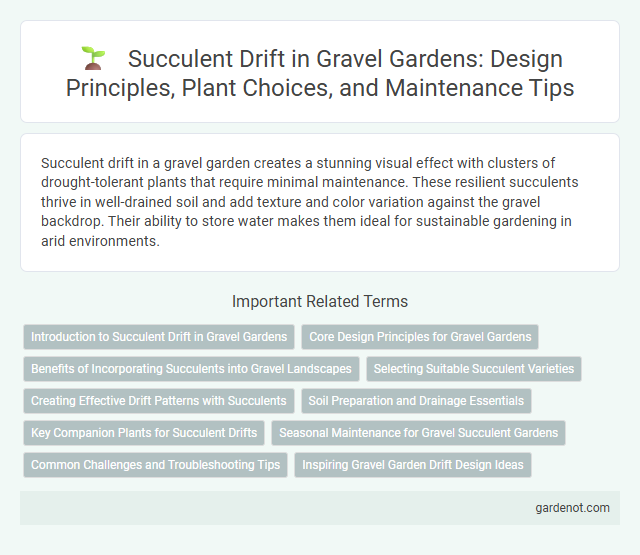Succulent drift in a gravel garden creates a stunning visual effect with clusters of drought-tolerant plants that require minimal maintenance. These resilient succulents thrive in well-drained soil and add texture and color variation against the gravel backdrop. Their ability to store water makes them ideal for sustainable gardening in arid environments.
Introduction to Succulent Drift in Gravel Gardens
Succulent Drift in gravel gardens showcases drought-tolerant plants that thrive in well-draining, nutrient-poor soils, offering vibrant color and textural contrast. This technique uses a mix of sedums, echeverias, and sempervivums arranged to mimic natural plant dispersal and maximize water efficiency. Incorporating Succulent Drift enhances biodiversity while reducing maintenance and irrigation requirements.
Core Design Principles for Gravel Gardens
Succulent drift in gravel gardens emphasizes water-efficient landscaping by grouping drought-tolerant plants to create visually appealing, low-maintenance zones. The core design principles include maximizing soil drainage, selecting species with similar moisture needs, and arranging plants to enhance texture contrast and seasonal interest. This approach fosters sustainable growth, reduces irrigation demands, and accentuates the natural beauty of gravel mulch.
Benefits of Incorporating Succulents into Gravel Landscapes
Incorporating succulents into gravel gardens enhances water efficiency by requiring minimal irrigation, making them ideal for drought-prone regions. Their diverse textures and colors add year-round visual interest and reduce maintenance compared to traditional plants. Succulents also improve soil stability by preventing erosion, creating a sustainable and eco-friendly landscape solution.
Selecting Suitable Succulent Varieties
Selecting suitable succulent varieties for a gravel garden involves choosing drought-tolerant species such as Echeveria, Sedum, and Sempervivum that thrive in well-draining, rocky soil conditions. These succulents require minimal water and adapt well to full sun exposure, making them ideal for low-maintenance landscapes. Incorporating a mix of colors, shapes, and sizes enhances visual interest while ensuring resilience against harsh environmental factors.
Creating Effective Drift Patterns with Succulents
Creating effective drift patterns with succulents involves grouping similar species in clusters that mimic natural growth habits, enhancing texture and visual flow in a gravel garden. Selecting drought-tolerant varieties such as Sedum, Echeveria, and Sempervivum ensures resilience and low maintenance while providing diverse shapes and colors. Strategic placement with varying heights and densities amplifies aesthetic appeal and promotes healthy growth by optimizing sunlight exposure and airflow.
Soil Preparation and Drainage Essentials
Succulent drift thrives in well-draining soil with a sandy or gritty texture to prevent root rot and promote healthy growth. Incorporate organic matter like compost to balance moisture retention while ensuring excess water drains promptly. Proper grading and the use of gravel or coarse sand improve drainage efficiency, essential for sustaining succulent vitality in a gravel garden.
Key Companion Plants for Succulent Drifts
Key companion plants for succulent drifts include drought-tolerant species such as lavender, sedum, and ornamental grasses, which enhance texture and color contrast while thriving in similar conditions. These plants improve soil drainage and support pollinators, creating a balanced and resilient gravel garden ecosystem. Proper spacing and diversity among companions help prevent overcrowding and promote healthy succulent growth.
Seasonal Maintenance for Gravel Succulent Gardens
Succulent drift in gravel gardens requires strategic seasonal maintenance to prevent overcrowding and ensure healthy growth. Pruning dead or leggy shoots during early spring promotes airflow and reduces disease risks. Mulching with coarse gravel retains moisture and suppresses weeds, optimizing conditions for drought-tolerant succulents throughout the year.
Common Challenges and Troubleshooting Tips
Succulent drift in gravel gardens often results from insufficient drainage, causing roots to rot and plants to lose vigor. Address this by ensuring a well-draining soil mix and avoiding overwatering to maintain optimal moisture levels. Regularly inspect succulents for signs of fungal infections or pests and promptly remove affected leaves to prevent spread.
Inspiring Gravel Garden Drift Design Ideas
Succulent drift designs in gravel gardens create visually striking landscapes by grouping drought-tolerant plants with varying textures, shapes, and colors for a natural, flowing effect. Incorporate species such as Echeveria, Sedum, and Sempervivum in clusters, allowing their contrasting leaf forms and hues to enhance the garden's visual appeal while minimizing maintenance. Strategic placement within gravel beds promotes excellent drainage and heat retention, fostering healthy growth and a sustainable, low-water garden display.
Succulent drift Infographic

 gardenot.com
gardenot.com